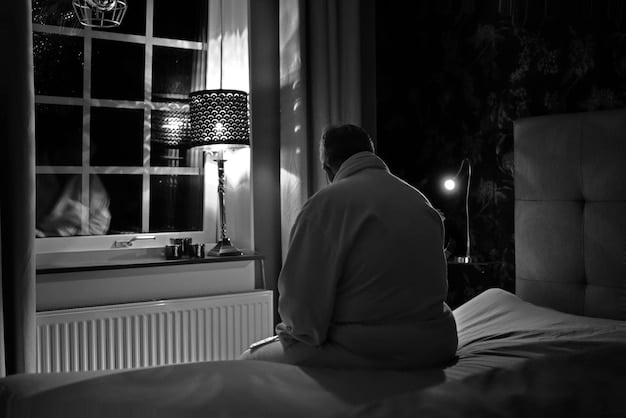The Silent Struggle: Understanding and Overcoming Male Depression in the US

Male depression in the US is often an unseen crisis, characterized by unique symptoms and societal pressures that prevent men from seeking necessary help, highlighting an urgent need for greater awareness and tailored support systems to foster healing and well-being.
For too long, the narrative around mental health has skewed towards symptoms more commonly recognized in women, leaving a significant portion of the population feeling misunderstood and overlooked. One of the most critical, yet frequently ignored, issues is The Silent Struggle: Understanding and Overcoming Male Depression in the US. This often-unspoken challenge affects millions, manifesting differently in men due to societal expectations and cultural norms surrounding masculinity. It’s a complex interplay of biology, environment, and ingrained beliefs that can make recognizing and addressing depression in men particularly difficult.
The Hidden Face of Male Depression
The perception of depression often involves obvious sadness or emotional outbursts, yet in men, it frequently presents in more subdued, and sometimes aggressive, ways. Societal pressures on men to be strong, stoic, and self-reliant often lead to internalizing emotions rather than seeking help, contributing to the “silent” nature of this struggle. This cultural conditioning can make it incredibly challenging for men to acknowledge their feelings of vulnerability or distress, even to themselves.
Men might express depression through irritability, anger, escapist behaviors, or physical complaints, rather than overt sadness. This can lead to misdiagnosis or a complete lack of diagnosis, as these symptoms are less commonly associated with depression. The emphasis on problem-solving and suppressing emotions can also manifest as a tendency to “push through” overwhelming feelings, rather than addressing them directly, often worsening the underlying condition over time.
Common Misconceptions and Stereotypes
Stereotypes about masculinity create a powerful barrier. The idea that “real men don’t cry” or “men don’t get depressed” is deeply ingrained, making it difficult for men to admit they are struggling. These beliefs are harmful, fostering an environment where mental health issues are seen as weaknesses rather than legitimate health conditions. Challenging these stereotypes is a crucial step towards opening up conversations and encouraging men to seek help. It’s about redefining strength not as emotional suppression, but as the courage to confront one’s vulnerabilities.
Symptoms Beyond Sadness
While classic symptoms like persistent sadness or loss of interest are present, male depression often manifests differently.
- Increased anger or irritability: Rather than appearing sad, men might become more easily provoked or show sudden outbursts of anger.
- Escapist behaviors: This can include excessive drinking, drug use, gambling, or reckless driving as a way to self-medicate or numb emotional pain.
- Physical symptoms: Unexplained headaches, digestive problems, or chronic pain that doesn’t respond to treatment can be signs of underlying depression.
- Workaholism or social withdrawal: Men might immerse themselves in work or hobbies to avoid confronting their feelings, or they might pull away from friends and family.
Recognizing these varied symptoms is vital for early intervention. Family members and friends are often the first to notice these changes, making their awareness and understanding critical in guiding men towards support.
Societal Pressures and Cultural Norms
The pressure on men to embody traditional masculine traits, such as stoicism, self-reliance, and emotional suppression, significantly impacts their mental health. From a young age, boys are often taught to “tough it out” and not express vulnerability, fostering a belief that showing emotion is a sign of weakness. This conditioning extends into adulthood, where men feel immense pressure to be providers, protectors, and pillars of strength, even when struggling internally.
These societal expectations create a significant barrier to seeking help. Admitting to feeling depressed can feel like a failure to uphold these masculine ideals, leading to feelings of shame and isolation. The fear of being perceived as “weak” or “less than” can outweigh the desire for relief from mental anguish, ultimately perpetuating the silent struggle. The cultural narrative often dictates that men should solve their own problems, fostering a sense of isolation when professional help is clearly needed.

This constant pressure can lead to men “masking” their depression with other behaviors. For example, some men may dive deeper into work or hobbies, becoming obsessive to avoid confronting their inner turmoil. Others might resort to alcohol or drug abuse, seeing it as a more socially acceptable coping mechanism than admitting to emotional distress. These coping strategies, while providing temporary relief, often exacerbate the underlying depressive symptoms in the long run.
The “Strong Man” Persona
The “strong man” persona, deeply embedded in American culture, reinforces the idea that men should always be in control and never show signs of distress. This rigid expectation not only prevents men from seeking help but also makes it harder for them to even recognize their own symptoms. They may dismiss feelings of sadness or anxiety as temporary “bad moods” or stress, rather than acknowledging them as indicators of a deeper issue. This self-denial can prolong suffering and delay critical intervention.
The consequences of this pervasive persona are dire, contributing to higher rates of suicide among men, particularly in certain age groups. It highlights the urgent need for a cultural shift that embraces emotional openness and encourages men to prioritize their mental well-being without fear of judgment.
The Role of Media and Pop Culture
Media and popular culture often reinforce these outdated notions of masculinity. From action heroes who never waver to advertising that portrays men as rugged and emotionless, these depictions subtly communicate what it means to be “manly.” While there’s a growing movement towards more nuanced portrayals of masculinity, the traditional archetypes remain dominant, further cementing harmful expectations. This makes it difficult for men to see themselves reflected in narratives that depict vulnerability and help-seeking behaviors as strengths, rather than weaknesses.
Cultural narratives also often romanticize resilience through stoicism, equating emotional suppression with strength. This needs to be challenged by media that showcases men navigating mental health challenges openly and advocating for help, normalizing the process for countless others who might be silently suffering.
Workplace and Family Expectations
Workplace cultures can also play a role, with environments that value aggression, competitiveness, and relentless drive often implicitly discouraging emotional expression. Similarly, family expectations can contribute to the pressure, as men often feel obligated to be the unwavering rock for their loved ones. These pressures, combined with a lack of education about male mental health, create a perfect storm where depression can flourish unseen and untreated. It’s a challenging cycle to break, but understanding these root causes is the first step toward building a more supportive and understanding environment for men.
Recognizing the Signs: What to Look For
Given the subtle and varied ways depression manifests in men, recognizing its signs requires careful attention and a shift in conventional understanding. Beyond the commonly associated sadness or melancholy, male depression often expresses itself through behavioral changes that might be misinterpreted as character flaws or simply stress. It’s crucial for individuals, families, and healthcare providers to be aware of these nuanced indicators to facilitate timely intervention.
One key area to observe is changes in behavior or personality. A man who was once calm and easygoing might become irritable, restless, or prone to sudden outbursts of anger. Conversely, a previously outgoing individual might become withdrawn, isolating themselves from friends and family. These shifts are often a cry for help, even if not explicitly verbalized.
Behavioral Indicators
Men often externalize their internal distress through actions rather than words. Instead of expressing sadness, they might:
- Engage in risky behaviors: This could range from reckless driving to excessive gambling, seeking an adrenaline rush to momentarily escape emotional pain.
- Increase substance use: Turning to alcohol or drugs to self-medicate is a common coping mechanism, leading to a vicious cycle of dependency and worsening mood.
- Develop destructive sleep patterns: This includes insomnia, particularly waking up in the early hours of the morning and being unable to fall back asleep, or excessive sleeping as a form of avoidance.
- Show decreased interest in hobbies or activities: What once brought joy or satisfaction now feels meaningless or burdensome.
These behavioral changes are often warning signs that should not be overlooked or dismissed as mere “phases.” They are often indicators of deeper struggles that require attention and support.
Emotional and Physical Symptoms
While less overt, emotional and physical symptoms are also present. Emotionally, men might experience a persistent feeling of emptiness, hopelessness, or numbness, which can be just as debilitating as intense sadness. They might struggle with concentration, decision-making, and memory, impacting their work and daily life. Physically, unexplained aches and pains, changes in appetite leading to significant weight loss or gain, and persistent fatigue despite adequate rest are common. These physical complaints are particularly insidious as they can often lead to repeated medical consultations without addressing the underlying mental health concern.
The interplay between the mind and body is profound, and often, the body will sound alarms when the mind is in distress. Recognizing these diverse symptoms is the first step toward breaking the cycle of silent suffering and opening the door to appropriate care. It requires empathy, patience, and a willingness to look beyond the surface.
Breaking the Silence: Encouraging Men to Seek Help
Encouraging men to seek help for depression requires a fundamental shift in how society views male mental health. It means actively working to destigmatize mental illness and creating environments where vulnerability is seen as a strength, not a weakness. This cultural transformation is a long-term goal, but there are immediate steps that can be taken to support men in their journey towards healing. It begins with open, non-judgmental conversations and providing accessible pathways to support.
One crucial strategy is to reframe the narrative around seeking help. Instead of portraying it as an admission of defeat, it should be presented as an act of courageous self-care and a proactive step towards a healthier, more fulfilling life. Educating men, their families, and communities about the unique manifestations of male depression is also vital. When symptoms are properly understood, they are less likely to be dismissed or misattributed.
Creating Safe Spaces for Expression
Establishing safe spaces where men feel comfortable discussing their emotions without judgment is paramount. This can take many forms:
- Support groups: Peer-led groups offer a unique opportunity for men to connect with others who understand their experiences, fostering a sense of community and shared struggle.
- Therapy tailored to men: Therapists who understand the nuances of male psychology can employ approaches that resonate better with men, such as problem-solving techniques or focusing on behavioral changes.
- Online forums and resources: Anonymous platforms can provide a low-barrier entry point for men to explore their feelings and learn about available support options.
These spaces should emphasize confidentiality and empathy, ensuring that men feel heard and respected.

The Role of Friends and Family
Friends and family members play a critical role in recognizing the signs of depression and encouraging men to seek help. It’s often easier for loved ones to spot changes in behavior or mood that the individual might be masking or unaware of. Approaching these conversations with empathy, patience, and without judgment is essential. Instead of accusatory language, focusing on observations and offering support can be more effective. For example, rather than saying, “You’re always irritable,” one might say, “I’ve noticed you seem more stressed lately, and I’m here for you if you want to talk.” This open invitation for dialogue can make a significant difference.
It’s also important for friends and family to educate themselves about male depression to avoid common pitfalls or misconceptions. Learning how to navigate conversations around mental health sensitively can foster trust and make it easier for men to open up about their struggles, ultimately leading to positive outcomes.
Treatment Approaches and Strategies
Addressing male depression effectively requires a multi-faceted approach that considers the unique ways men experience and express their symptoms. There’s no one-size-fits-all solution, and a combination of therapies, lifestyle adjustments, and potentially medication, often yields the best results. The key is to find strategies that resonate with the individual, respecting their preferences and comfort levels.
Psychotherapy, particularly cognitive-behavioral therapy (CBT) and interpersonal therapy (IPT), has proven effective for many men. These approaches focus on identifying negative thought patterns and behaviors, and developing healthier coping mechanisms. Therapists might tailor the approach to men by focusing on action-oriented strategies or linking emotional well-being to performance or physical health, which can be more appealing to those who resist traditional “talk therapy.”
Therapy Tailored for Men
Many men respond well to practical, solution-focused therapies.
- Cognitive Behavioral Therapy (CBT): Helps men identify and challenge negative thought patterns that contribute to depression, replacing them with more realistic and positive ones.
- Interpersonal Therapy (IPT): Focuses on improving relationship problems and social skills that may be contributing to or exacerbated by depression.
- Psychodynamic therapy: Explores how past experiences and unconscious patterns might be influencing current mental health struggles.
The therapeutic relationship itself is crucial; finding a therapist with whom a man feels comfortable and understood can greatly enhance the effectiveness of treatment. Many therapists specialize in men’s issues, which can be particularly beneficial.
Medication as a Part of Treatment
Antidepressants can be an effective component of a comprehensive treatment plan for moderate to severe depression, especially when combined with therapy. These medications work by balancing brain chemicals that affect mood. It’s important to note that medication is not a quick fix and requires regular consultation with a healthcare provider to monitor effectiveness and manage side effects. The decision to use medication should always be made in collaboration with a doctor, considering individual health profiles and symptoms. For some men, medication can provide the necessary relief to engage more effectively in therapy and daily life.
Lifestyle Adjustments and Self-Care
Beyond formal treatment, lifestyle adjustments play a significant role in managing and overcoming depression. Regular physical activity, a balanced diet, adequate sleep, and stress reduction techniques can greatly improve mood and overall well-being. Engaging in hobbies, spending time in nature, and maintaining social connections are also vital for mental health. These self-care strategies are not sidelines to treatment but integral components that empower men to take an active role in their recovery. Integrating these practices into daily routines can foster resilience and prevent relapse.
Preventive Measures and Long-Term Well-being
Preventing depression in men, and fostering long-term well-being, requires a proactive and holistic approach that addresses underlying societal pressures and promotes healthy coping mechanisms from an early age. It’s about building resilience and emotional literacy, equipping men with the tools they need to navigate life’s challenges without succumbing to silent suffering. This includes promoting open dialogue, fostering supportive communities, and providing ongoing education.
One crucial preventive measure is the widespread promotion of emotional literacy in boys and young men. Teaching them to recognize, understand, and express their emotions in healthy ways can significantly reduce the likelihood of internalizing distress later in life. This involves educators, parents, and community leaders actively demonstrating and encouraging emotional openness, challenging traditional norms that equate stoicism with strength.
Cultivating Emotional Literacy
Teaching boys and young men to recognize and express their feelings is a powerful preventive tool. This includes:
- Early education programs: Incorporating mental health awareness and emotional intelligence into school curricula helps normalize these discussions from a young age.
- Parental guidance: Parents can model healthy emotional expression and encourage their sons to talk about their feelings, validating their experiences.
- Mentorship programs: Providing young men with positive male role models who demonstrate emotional strength through vulnerability can be transformative.
These efforts can lay the groundwork for a generation of men who are more attuned to their mental health and less afraid to seek help.
Fostering Supportive Communities
Building strong, supportive communities where men feel connected and valued is essential for long-term well-being. Social isolation is a significant risk factor for depression, and fostering genuine connections can act as a buffer against mental health decline. This includes encouraging participation in community groups, sports teams, and volunteer activities that provide a sense of belonging and purpose. These connections offer opportunities for men to share experiences, offer mutual support, and feel less alone in their struggles, creating a network of resilience.
Moreover, communities can actively promote mental health awareness campaigns and provide accessible resources, ensuring that men know where to turn when they need help. This collective responsibility can slowly chip away at the stigma surrounding male depression.
Ongoing Self-Care and Mental Health Check-ups
Just as physical health requires regular check-ups, so too does mental health. Encouraging men to view mental health care as a routine part of their overall well-being is vital. This includes:
- Regular self-assessment: Encouraging men to periodically reflect on their emotional state and identify any changes that might warrant attention.
- Proactive coping strategies: Developing a repertoire of stress-reduction techniques, mindfulness practices, and healthy coping mechanisms to manage daily pressures.
- Seeking professional guidance: Normalizing the idea of consulting a therapist or counselor for preventive care or when subtle signs of distress emerge, rather than waiting for a crisis.
These proactive steps empower men to take ownership of their mental health journey, fostering resilience and promoting a sustained state of well-being throughout their lives.
Resources and Support Networks in the US
Navigating the landscape of mental health support can be daunting, but the United States offers a wealth of resources and networks specifically designed to help individuals, including men, struggling with depression. Accessing these resources is a critical step in overcoming the silent struggle, providing pathways to professional help, peer support, and educational materials. Understanding where to find help is the first step toward recovery and long-term well-being.
Many organizations and government initiatives are dedicated to improving mental health awareness and access to care. These resources often provide comprehensive information on symptoms, treatment options, and how to find qualified professionals. Furthermore, a growing number of services are being tailored to the unique needs of men, acknowledging the specific cultural and societal factors that influence their mental health.
National Organizations and Helplines
Several national organizations provide invaluable support for mental health, often with specific resources for men. These can be crucial first points of contact:
- National Alliance on Mental Illness (NAMI): Offers support groups, educational programs, and advocacy for individuals and families affected by mental illness.
- Mental Health America (MHA): Provides screening tools, information, and advocacy to promote mental health and prevent mental illness.
- Substance Abuse and Mental Health Services Administration (SAMHSA) National Helpline: A confidential, 24/7 free hotline, acting as a referral service for individuals and families facing mental and/or substance use disorders.
These organizations are foundational in providing general support and guidance, often leading to more specialized resources.
Online Platforms and Digital Health
The rise of digital health platforms has made mental health support more accessible than ever, particularly for those who may be hesitant to seek in-person care. Online therapy platforms, mental wellness apps, and forums offer convenience and a degree of anonymity that can be appealing to men. These resources provide flexibility, allowing individuals to access support from the comfort of their own homes and on their own schedules. They can be particularly useful for those in rural areas or with limited access to traditional mental health services.
Community-Based and Local Support
Beyond national resources, local communities across the US often have tailored programs and support groups. These can include community mental health centers, hospital-based programs, and peer support groups led by individuals with lived experience. Connecting with local resources can provide a sense of immediate community and practical support tailored to specific regional needs. Checking with local health departments or community centers is a good starting point to discover what’s available nearby.
| Key Point | Brief Description |
|---|---|
| 😔 Silent Symptoms | Male depression often presents as irritability, anger, or physical pain, not just sadness. |
| 💪 Societal Pressure | Expectations of male stoicism and self-reliance hinder men from seeking help. |
| 🤝 Encourage Dialogue | Creating safe spaces and fostering open conversations are crucial for support. |
| 💡 Treatment Paths | Therapy, medication, and lifestyle changes form a comprehensive approach to recovery. |
Frequently Asked Questions
Unlike classic symptoms of sadness, male depression often manifests as irritability, anger, reckless behavior, escapism through substances or work, and physical ailments like chronic pain. They might also withdraw socially or experience increased fatigue and sleep disturbances, which can be easily overlooked or attributed to other causes, making diagnosis challenging.
Societal expectations of masculinity, such as stoicism and self-reliance, significantly deter men from seeking help. The fear of being perceived as weak or unable to cope often leads to internalizing emotions and suffering in silence. A lack of awareness about how depression manifests in men also contributes to their reluctance to seek professional support.
Effective treatments often include psychotherapy, such as Cognitive Behavioral Therapy (CBT) or Interpersonal Therapy (IPT), sometimes combined with medication. Lifestyle adjustments like regular exercise, balanced nutrition, adequate sleep, and stress management techniques are also crucial. Tailored approaches that resonate with men’s communication styles can improve engagement.
Friends and family can provide crucial support by listening without judgment, validating feelings, and encouraging professional help. It’s important to approach conversations with empathy, focusing on observed behaviors rather than making accusations. Offering practical support, such as helping to find resources or accompany them to an appointment, can also be beneficial.
Yes, many national organizations like NAMI and MHA offer resources, and SAMHSA provides a national helpline. Increasingly, online platforms and local community mental health centers are providing male-specific support groups and tailored therapy services recognizing the unique needs and barriers men face in addressing their mental health.
Conclusion
The Silent Struggle: Understanding and Overcoming Male Depression in the US is a critical public health issue that demands greater attention and empathy. By challenging outdated notions of masculinity, fostering open conversations, and providing accessible, tailored support systems, society can begin to dismantle the barriers that prevent men from seeking help. Recognizing the diverse ways depression manifests in men—beyond conventional sadness—is the first step towards a future where emotional vulnerability is seen as a sign of strength, and every man feels empowered to prioritize his mental well-being without fear of judgment. It is a shared responsibility, requiring collective effort to create a more understanding and supportive environment for all.





